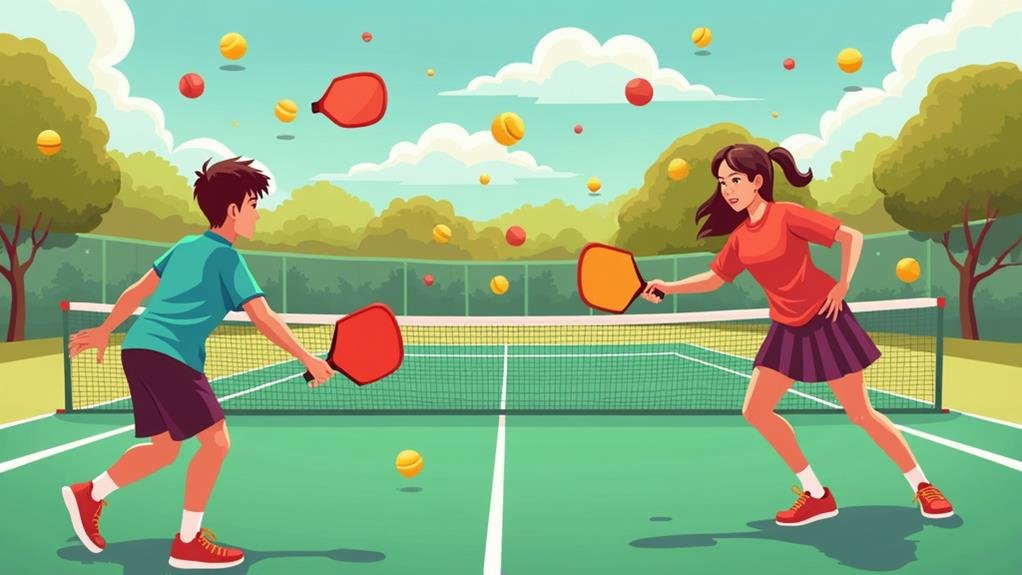To master pickleball, you need to know key terms that shape the game. Familiarize yourself with the "kitchen," a non-volley zone that keeps you strategic near the net. Understand shot types like "dinks," soft shots that force opponents to react quickly, and "volleys," where you hit the ball before it bounces. Keep score by knowing that points only come from the server and games typically go to 11. Learning terms like "ace" and "third shot drop" can elevate your play. As you continue, you'll discover even more terminology that can enhance your skills on the court.
Key Takeaways
- Understanding court dimensions, including the non-volley zone (kitchen), is crucial for effective gameplay and strategy.
- Familiarize yourself with common shot types like volleys, drop shots, and overhead smashes to enhance your skills.
- The scoring system allows points only when serving, typically played to 11 or 15 points, requiring a two-point lead to win.
- Master various serving techniques, such as the underhand serve and slice serve, to disrupt opponents' rhythm.
- Being aware of faults and violations, like the double bounce rule, helps maintain game flow and improves performance.
Basic Rules of Pickleball

Have you ever wondered what makes the game of pickleball so unique? It's not just the combination of tennis, badminton, and ping pong; it's also the basic rules that create a dynamic and engaging playing experience.
Understanding game etiquette is crucial for any player looking to excel. For instance, always respect your opponents—call out the score before serving and acknowledge good plays, regardless of which side made them.
Player positioning is another key aspect. You'll want to maintain a strategic stance to maximize your effectiveness on the court.
When serving, stand behind the baseline and ensure your feet don't cross it until you hit the ball. After the serve, position yourself to cover the court effectively, recognizing when to shift to the net or retreat to the baseline.
Court Dimensions and Areas
Understanding the basic rules of pickleball lays the groundwork for appreciating the game's layout and court dimensions. The pickleball court has specific measurements that create distinct playing zones, ensuring the game flows smoothly and fairly.
Here's a quick overview of the court dimensions:
| Area | Dimensions | Purpose |
|---|---|---|
| Total Court | 20' x 44' | Full playing area for doubles and singles |
| Non-Volley Zone | 7' from the net | Prevents players from volleying close to the net |
| Service Area | 10' x 15' | Designated area for serving |
| Baseline | 22' from the net | Back boundary for points |
In pickleball, understanding this court layout is crucial for strategizing your plays. The playing zones, including the non-volley zone and service area, dictate your positioning and shot selection. Familiarizing yourself with these dimensions not only enhances your gameplay but also optimizes your overall experience on the court. So, take the time to visualize these areas, and you'll find yourself playing with more confidence and precision.
Pickleball Equipment Essentials
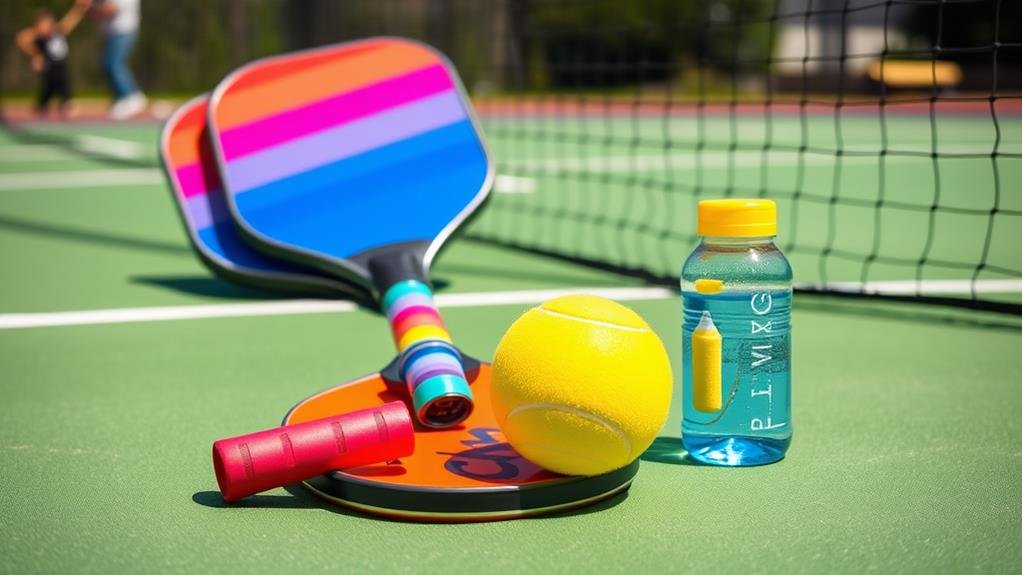
When stepping onto the pickleball court, having the right equipment can make all the difference in your game. The fundamentals start with your paddle. There are several paddle types to choose from, including wood, composite, and graphite. Each type offers unique benefits; for instance, composite paddles provide a great balance of power and control, while graphite paddles are lightweight, enhancing maneuverability.
Next up is the pickleball itself. The ball materials vary, typically made from plastic with small holes, which affect its flight and bounce. Indoor balls are softer and have fewer holes, making them ideal for gym environments, while outdoor balls are more durable and designed to withstand wind and rougher surfaces.
Investing in quality equipment tailored to your playing style isn't just smart; it's essential for improving your skills.
Whether you're a beginner or a seasoned player, understanding the nuances of paddle types and ball materials can elevate your game and enhance your overall experience on the court.
Scoring System Explained
With your gear sorted, it's time to grasp the scoring system that governs pickleball matches. Understanding the various scoring methods is crucial for strategizing your gameplay. In pickleball, you can only score points when serving, which makes the point system unique compared to other racquet sports.
Here's a quick overview of how scoring works:
| Serve Type | Points Awarded | Total Points Needed to Win |
|---|---|---|
| Regular Games | 1 point | 11 (win by 2) |
| Tournament Matches | 1 point | 11 or 15 (win by 2) |
| Doubles Matches | 1 point | 11 or 15 (win by 2) |
In a standard game, you'll play to 11, but in tournaments, games can go up to 15. Remember, you must win by at least two points, adding an exciting layer of competitiveness. Keep track of your score, as it dictates your strategy and mindset on the court. Knowing the point system will enhance your gameplay and help you adapt to various match situations. Embrace this knowledge, and you'll feel more confident during your matches!
Common Shot Types
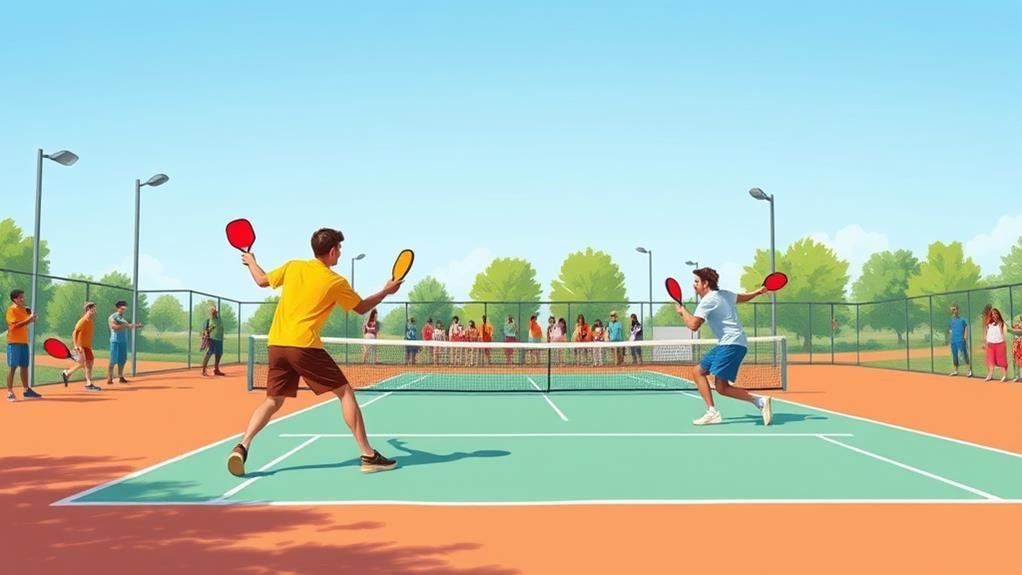
Mastering the common shot types in pickleball can significantly elevate your game. Understanding each shot's purpose and technique allows you to strategize effectively against your opponents.
The forehand drive is a powerful shot that propels the ball with speed and accuracy, making it hard for your opponent to return. Conversely, a backhand slice helps you change the ball's trajectory, adding a spin that can catch your opponent off-guard.
If you're looking to soften your play, the drop shot is perfect for placing the ball just over the net, drawing your opponent in. Utilizing proper volley technique allows you to intercept the ball before it bounces, keeping the pressure on your opponent.
When you have a high ball, an overhead smash can be your best friend, delivering a decisive point. Incorporate a spin serve to confuse your opponent right from the start, while the dink shot is essential for those strategic, close-net exchanges.
Lastly, the approach shot sets you up for the next play, allowing you to dictate the pace. Master these shots, and watch your pickleball skills soar!
Faults and Violations
In pickleball, understanding the rules surrounding faults and violations is just as important as mastering your shots. Knowing the different fault types can save you from frustration during a match, ensuring you play smoothly and efficiently.
Here are some key aspects to keep in mind:
- Serving Errors: A foot fault occurs if you step on or over the baseline while serving.
- Net Violations: Touching the net with your paddle or body during play results in a fault.
- Double Bounce Rule: If the ball isn't allowed to bounce once on each side after the serve, it's a violation.
When a fault occurs, your opponent typically earns a point or the serve changes hands, depending on the situation.
Violation penalties can vary, so it's crucial to be aware of what's at stake. Each fault not only affects the score but can also influence your strategy and momentum.
Game Formats and Variations
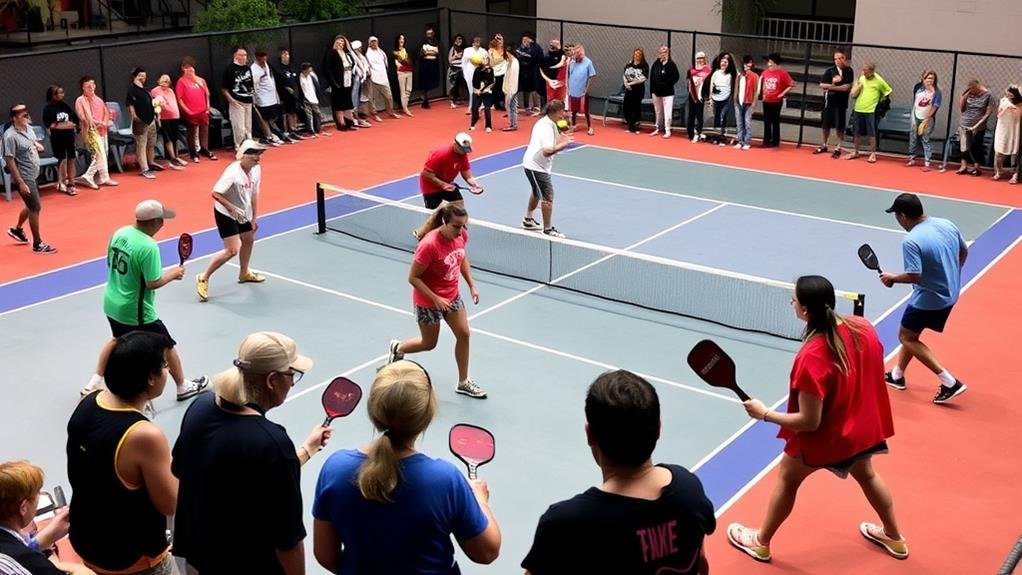
Pickleball offers a variety of game formats and variations that can enhance your playing experience and keep matches exciting. Whether you're looking for competitive play or casual fun, there's something for everyone.
Here's a quick overview of popular formats:
| Format | Description | Ideal For |
|---|---|---|
| Singles Matches | One-on-one competition | High skill levels |
| Doubles Play | Teams of two, promoting teamwork | Recreational play |
| Mixed Doubles | One male and one female on each team | All skill levels |
| Round Robin | Each player/team plays against all others | Tournaments |
| Ladder Play | Players compete to ascend ranks | Skill development |
These formats cater to various skill levels, ensuring everyone can join in the fun. In singles matches, you'll hone your skills against an opponent, while doubles play enhances strategy and communication. Tournament formats like round robin and ladder play provide structured competition for those wanting to challenge themselves. So, gather your friends or sign up for a local tournament; the world of pickleball awaits you!
Serving Techniques
When you step onto the court, nailing your serving techniques can set the tone for the entire match. Mastering various serves not only gives you an edge but also disrupts your opponent's rhythm.
Here are a few key techniques to consider:
- Underhand Serve: A sneaky option that catches opponents off guard.
- Slice Serve: Adds sideways spin to keep your opponent guessing.
- Top Spin: Creates a high bounce, making it tough for your opponent to return.
You might also explore the backhand serve for a change-up, or even the jump serve, which can add an extra element of surprise.
Understanding spin effects on your serves is crucial; they can drastically alter how the ball behaves upon landing.
Experiment with different techniques and find what works best for you. The key is to remain unpredictable and strategic.
By incorporating these serving techniques into your game, you'll not only enhance your skill set but also elevate your overall performance on the court.
Every serve is an opportunity—make it count!
Strategy Terminology
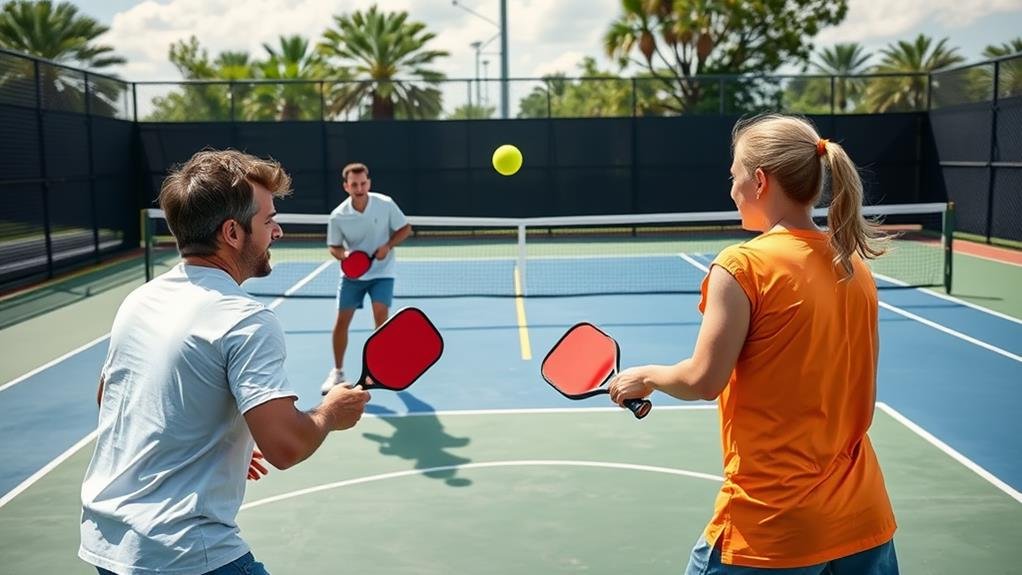
After mastering your serving techniques, understanding strategy terminology can significantly enhance your game. Knowing the difference between offensive strategies and defensive tactics is crucial for elevating your pickleball skills.
Offensive strategies focus on putting pressure on your opponent. This involves aggressive shot placements, like volleys and smashes, that aim to win points quickly. You'll want to utilize angles and speed to keep your opponent guessing and off balance.
Think about positioning yourself at the net to capitalize on quick exchanges, allowing you to maintain control of the game.
On the flip side, defensive tactics are about minimizing mistakes and keeping the ball in play. Here, you'll focus on returning shots with precision, aiming to push your opponent into making errors.
Using techniques like dinks and drop shots can help you regain control of the rally when you're on the back foot.
Pickleball Lingo and Slang
Often, players find themselves immersed in a unique vocabulary that defines the pickleball culture. Understanding pickleball jargon and slang meanings can enhance your game and social interactions on the court.
Here's a quick look at some popular terms you'll likely hear:
- Dink: A soft shot that drops just over the net, designed to force your opponent to hit upward.
- Kitchen: The non-volley zone near the net where players can't hit the ball unless it bounces first.
- Third Shot Drop: A strategic shot played after the serve and return, aimed to land softly in the kitchen.
Conclusion
Now that you've got the scoop on essential pickleball terms, you're ready to step onto the court with confidence. Think of these concepts as your trusty paddle—each term helps you navigate the game's intricacies. Whether you're serving up aces or diving for a volley, knowing the lingo will enhance your play and connect you with fellow enthusiasts. So grab your gear, embrace the challenge, and let the rhythm of the game carry you to new heights!

